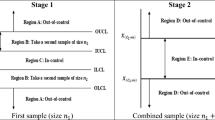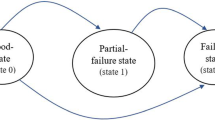Abstract
In this paper, we consider an availability maximization problem for a partially observable system subject to random failure. System deterioration is described by a hidden, continuous-time homogeneous Markov process. While the system is operational, multivariate observations that are stochastically related to the system state are sampled through condition monitoring at discrete time points. The objective is to design an optimal multivariate Bayesian control chart that maximizes the long-run expected average availability per unit time. We have developed an efficient computational algorithm in the semi-Markov decision process (SMDP) framework and showed that the availability maximization problem is equivalent to solving a parameterized system of linear equations. A numerical example is presented to illustrate the effectiveness of our approach, and a comparison with the traditional age-based replacement policy is also provided.

Similar content being viewed by others
References
Ait Kadi, D., Beaucaire, C., & Cleroux, R. (2006). A periodic maintenance model with used equipment and random minimal repair. Naval Research Logistics, 37, 855–865.
Barlow, R., & Hunter, L. (1960). Optimum preventive maintenance policies. Operations Research, 8, 90–100.
Barlow, R., & Proschan, F. (1975). Statistical theory of reliability and life testing: probability models. New York: Holt, Rinehart & Winston.
Barlow, R., Hunter, L., & Proschan, F. (1963). Optimum checking procedures. Journal of the Society for Industrial and Applied Mathematics, 4, 1078–1095.
Ben-Daya, M., & Rahim, M. A. (2000). Effect of maintenance on the economic design of \(\bar{X} \) control chart. European Journal of Operational Research, 120, 131–143.
Bertolini, M., & Bevilacqua, M. (2006). A combined goal programming—AHP approach to maintenance selection problem. Reliability Engineering & Systems Safety, 91, 839–848.
Biswas, A., & Sarkar, J. (2000). Availability of a system maintained through several imperfect repairs before a replacement or a perfect repair. Statistics & Probability Letters, 50, 105–114.
Calabrese, J. M. (1995). Bayesian process control for attributes. Management Science, 41, 637–645.
Cassady, C. R., Bowden, R. O., Liew, L., & Pohl, E. A. (2000). Combining preventive maintenance and statistical process control: a preliminary investigation. IIE Transactions, 32, 471–478.
Chen, D. Y., & Trivedi, K. S. (2005). Optimization for condition-based maintenance with semi-Markov decision process. Reliability Engineering & Systems Safety, 90, 25–29.
Chow, C. S., & Tsitsiklis, J. N. (1988). An optimal multigrid algorithm for continuous state discrete time stochastic control. In Proceedings of the 27th conferences on decision and control, Austin, Texas, USA (pp. 1908–1912).
Chow, C. S., & Tsitsiklis, J. N. (1991). An optimal one-way multigrid algorithm for discrete-time stochastic control. IEEE Transactions on Automatic Control, 36, 898–914.
Christer, A., Wang, W., & Sharp, J. M. (1997). A state space condition monitoring model for furnace erosion prediction and replacement. European Journal of Operational Research, 101, 1–14.
Grall, A., Berenguer, C., & Dieulle, L. (2002). A condition-based maintenance policy for stochastically deteriorating systems. Reliability Engineering & Systems Safety, 76, 167–180.
Guihenineuc-Jouyaux, C., & Robert, C. P. (1998). Discretization of continuous Markov chains and Markov chain Monte Carlo convergence assessment. Journal of the American Statistical Association, 93, 1055–1067.
Gupta, A., & Lawsirirat, C. (2006). Strategically optimum maintenance of monitoring-enabled multi-component systems using continuous-time jump deterioration models. Journal of Quality in Maintenance Engineering, 12, 306–329.
Jardine, A. K. S., Lin, D. M., & Banjevic, D. (2006). A review on machinery diagnostics and prognostics implementing condition-based maintenance. Mechanical Systems and Signal Processing, 20, 1483–1510.
Jiang, X., Makis, V., & Jardine, A. K. S. (2001). Optimal repair/replacement policy for a general repair model. Advances in Applied Probability, 33, 206–222.
Jiang, R., Kim, M. J., & Makis, V. (2010). Availability maximization under partial observations (Technical Report MIE-OR-TR2010-10). Available at http://www.mie.utoronto.ca/labs/qrml. Accessed 16 September 2010.
Kim, M. J., & Makis, V. (2009). Optimal maintenance policy for a multi-state deteriorating system with two types of failures under general repair. Computers & Industrial Engineering, 57, 298–303.
Kim, M. J., Makis, V., & Jiang, R. (2010). Parameter estimation in a condition-based maintenance model. Statistics & Probability Letters, 80, 1633–1639.
Lin, D., & Makis, V. (2003). Recursive filters for a partially observable system subject to random failure. Advances in Applied Probability, 35, 207–227.
Makis, V. (2008). Multivariate Bayesian control chart. Operations Research, 56, 487–496.
Makis, V. (2009). Multivariate Bayesian process control for a finite production run. European Journal of Operational Research, 194, 795–806.
Makis, V., & Jiang, X. (2003). Optimal replacement under partial observations. Mathematics of Operations Research, 28, 382–394.
Nenes, G., & Tagaras, G. (2007). The economically designed two-sided Bayesian \(\bar{X} \) control chart. European Journal of Operational Research, 183, 263–277.
Provost, S. B., & Rudiuk, E. M. (1996). The exact distribution of indefinite quadratic forms in noncentral normal vectors. Annals of the Institute of Statistical Mathematics, 48, 381–394.
Rahim, M., & Banerjee, P. (1993). A generalized model for the economic design of \(\bar{X} \) control charts for production systems with increasing failure rate and early replacement. Naval Research Logistics, 40, 787–809.
Sarkar, J., & Chaudhuri, G. (1999). Availability of a system with gamma life and exponential repair time under a perfect repair policy. Statistics & Probability Letters, 43, 189–196.
Sheu, S. H., & Griffith, W. S. (2002). Extended block replacement policy with shock models and used items. European Journal of Operational Research, 140, 50–60.
Tagaras, G. (1988). An integrated cost model for the joint optimization of process control and maintenance. The Journal of the Operational Research Society, 39, 757–766.
Taylor, R. W. (1996). A linear programming model to manage the maintenance backlog. Omega, 24, 217–227.
Tijms, H. C. (1994). Stochastic models—an algorithmic approach. New York: Wiley.
Wang, W. (2000). A model to determine the optimal critical level and monitoring intervals in condition-based maintenance. International Journal of Production Research, 38, 1425–1436.
Wang, W. (2006). A two-stage prognosis model in condition based maintenance. European Journal of Operational Research, 182, 1177–1187.
Wu, J. M., & Makis, V. (2008). Economic and economic-statistical design of a chi-square chart for CBM. European Journal of Operational Research, 188, 516–529.
Yang, J. B., & Makis, V. (2000). Dynamic response of residuals to external deviations in a controlled production process. Technometrics, 42, 290–299.
Yeung, T. G., Cassady, C. R., & Schneider, K. (2008). Simultaneous optimization of control chart and age-based preventive maintenance policies under an economic objective. IIE Transactions, 40, 147–159.
Author information
Authors and Affiliations
Corresponding author
Appendices
Appendix 1
The Kolmogorov’s backward differential equations are given by:

Taking Laplace transform of the above equations gives:

where \(\tilde{P}_{ij}(s): = \int_{0}^{\infty} e^{ -st}P_{ij}(t)dt \) denotes the Laplace transform of P ij (t). Solving for \(\tilde{P}_{ij}(s) \) gives:

where:

Taking the inverse Laplace transform of above equation gives:

Finally, using the fact that \(\sum_{j \in S_{X}} P_{ij}(t) = 1\), i=0,1, the probability transition matrix is explicitly given by (3).
Appendix 2
Provost and Rudiuk (1996) showed that any indefinite quadratic form in normal vectors Q=U T AU, where U∼N d (μ,Σ), can be expressed as the difference of two linear combinations of independent non-central chi-square variables. In particular, let Σ=LL T, and λ 1,…,λ d denote the eigenvalues of L T AL. Then:

where \(W = \sum_{i = 1}^{p} \lambda_{i}\chi_{1}^{2}(\delta_{i}^{2}) \) and \(V= \sum_{i = p + 1}^{k} ( - \lambda_{i})\chi_{1}^{2}(\delta_{i}^{2}) \), and eigenvalues λ i >0 for i=1,…,p,λ i <0 for i=p+1,…,k, and λ i =0 for i=k+1,…,d. The random variables \(\chi_{1}^{2}(\delta_{i}^{2}) \) are distributed i.i.d. chi-square with one degree of freedom and non-centrality parameter \(\delta_{i}^{2} \). Using this fact, the authors were able to derive an explicit formula for the exact distribution function of Q=U T AU, which is stated below.
Theorem 1
(Provost and Rudiuk 1996)
Let \(Q = W - V = \sum_{j = 1}^{t} l_{j}T_{j} - \sum_{j = t + 1}^{t + w}l_{j}T_{j} \) where l j are positive real numbers and the T j are independent non-central chi-square variables with α j degrees of freedom and non-centrality parameter d j ,j=1,…,t+w. Let \(\alpha = \sum_{j = 1}^{t} \alpha_{j} / 2 \) and \(\alpha ' = \sum_{j = t+ 1}^{t + w} \alpha_{j} / 2 \), and b=(β −1+β′−1)/2, where β and β′ satisfy that |1−β/l j |<1,j=1,…,t, and |1−β′/l j |<1,j=t+1,…,t+w. Then provided α and α′ are not both nonnegative integers plus 1/2, for q≤0, the distribution function of Q is given by:

and for q>0, the distribution function of Q is given by:

where constants are given by:

Rights and permissions
About this article
Cite this article
Jiang, R., Kim, M.J. & Makis, V. A Bayesian model and numerical algorithm for CBM availability maximization. Ann Oper Res 196, 333–348 (2012). https://doi.org/10.1007/s10479-011-1013-1
Published:
Issue Date:
DOI: https://doi.org/10.1007/s10479-011-1013-1




